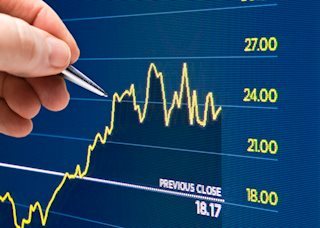Flag Patterns and How to Trade Them
|
Prices do not simply move up and down on a chart. Even when the security is in a trend, price will move with the trend, pause and correct, and then continue in the trend direction. Often there will be a pattern observed on the chart when price is in the pausing mode. Understanding and recognizing these patterns can offer traders higher probability trading opportunities.
One of the most common and popular patterns is the flag. The flag formation can either be bullish or bearish depending on the trend and shape. Let’s examine the flag patterns and learn how they can help improve trade decisions.
What Is a Flag Pattern?
The flag pattern is called a flag because the price action on a chart resembles a flag sitting on a pole. The pole is created by a sharp rise or fall in price and is then followed by a sideways trend that ends with another sharp rise or fall in price.
Bull Flag Patterns
A bull flag pattern is formed by a rally in price with an increase in volume. The high volume during the rally exhausts the buying pressure that was propelling price higher, which forms the pole. Price then consolidates, forming the flag, and then moves either sideways or against the trend as investors wait for more buying pressure to build up.
How to Trade a Bull Flag Pattern
When trading bull flag patterns, there are several potential entry areas for a long position. The first long entry can be taken once prices break upwards out of the flag itself. A second potential entry point is when price makes a new high. Lastly, traders can wait for prices to retest the breakout point by changing their chart to a lower time frame.
A stop loss can be set below the beginning of the flag formation or one times the Average True Range below the entry price.
The flag is often said to be flying at half-mast. This means that the move following the breakout of the flag is often equal in size to the move before the flag itself. So, the target for the trade can be a move equal to the size of the flagpole.
Traders should always identify their supply or demand zones, as they are more powerful and reliable than measured moves in patterns for setting targets.
For a long position, the next supply zone on the chart would make the best target.
Bear Flag Pattern
The bear flag is a consolidation pattern that follows a sharp selloff. The volume characteristics should be the same as what we saw for the bull flag. Increase in volume on the initial drop, then a drop in volume during the flag/consolidation, and an increase in volume after the breakdown.
How to Trade a Bear Flag Pattern
The trading strategy is similar to that of the bull flag pattern. Entry for a short is when prices break down to a fresh low, a breakout of the flag, or a retest of the breakout point after the flag was formed.
Keep in mind that the patterns are just an odds enhancer for Online Trading Academy’s Core Strategy. The Core Strategy should always be followed without fail. If you are not familiar with Core Strategy, enroll in an introductory class and learn strategies to help you navigate the financial markets.
Information on these pages contains forward-looking statements that involve risks and uncertainties. Markets and instruments profiled on this page are for informational purposes only and should not in any way come across as a recommendation to buy or sell in these assets. You should do your own thorough research before making any investment decisions. FXStreet does not in any way guarantee that this information is free from mistakes, errors, or material misstatements. It also does not guarantee that this information is of a timely nature. Investing in Open Markets involves a great deal of risk, including the loss of all or a portion of your investment, as well as emotional distress. All risks, losses and costs associated with investing, including total loss of principal, are your responsibility. The views and opinions expressed in this article are those of the authors and do not necessarily reflect the official policy or position of FXStreet nor its advertisers.
